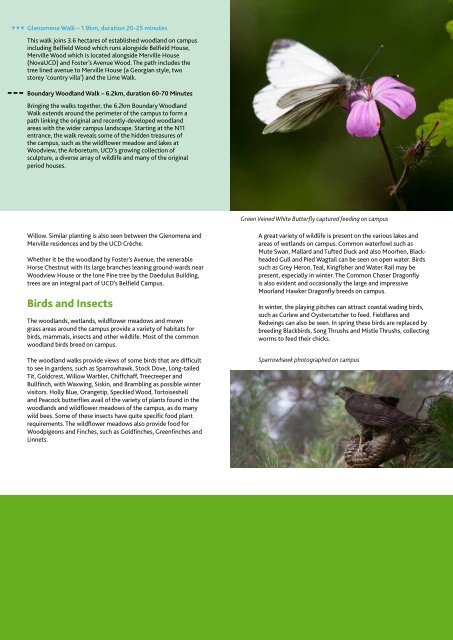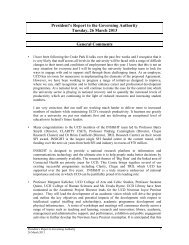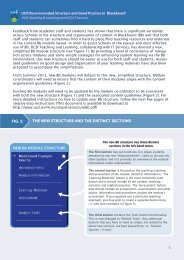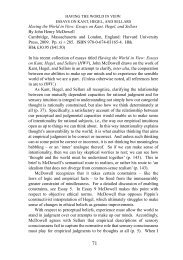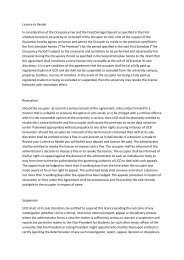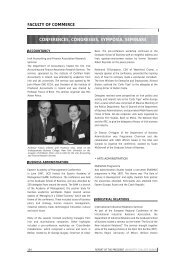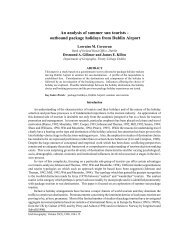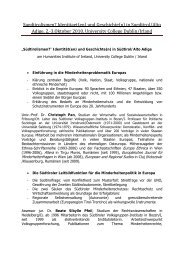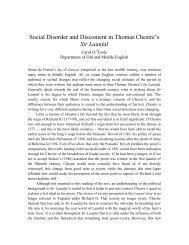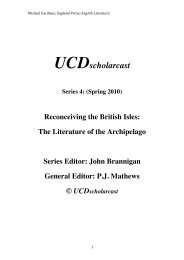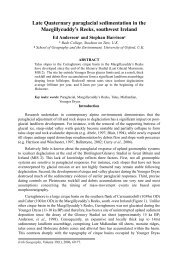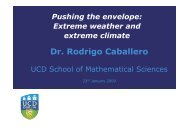UCD Woodland Walks Map and Guide - University College Dublin
UCD Woodland Walks Map and Guide - University College Dublin
UCD Woodland Walks Map and Guide - University College Dublin
Create successful ePaper yourself
Turn your PDF publications into a flip-book with our unique Google optimized e-Paper software.
Glenomena Walk – 1.9km, duration 20-25 minutes<br />
This walk joins 3.6 hectares of established woodl<strong>and</strong> on campus<br />
including Belfield Wood which runs alongside Belfield House,<br />
Merville Wood which is located alongside Merville House<br />
(Nova<strong>UCD</strong>) <strong>and</strong> Foster’s Avenue Wood. The path includes the<br />
tree lined avenue to Merville House (a Georgian style, two<br />
storey ‘country villa’) <strong>and</strong> the Lime Walk.<br />
Boundary <strong>Woodl<strong>and</strong></strong> Walk – 6.2km, duration 60-70 Minutes<br />
Bringing the walks together, the 6.2km Boundary <strong>Woodl<strong>and</strong></strong><br />
Walk extends around the perimeter of the campus to form a<br />
path linking the original <strong>and</strong> recently-developed woodl<strong>and</strong><br />
areas with the wider campus l<strong>and</strong>scape. Starting at the N11<br />
entrance, the walk reveals some of the hidden treasures of<br />
the campus, such as the wildflower meadow <strong>and</strong> lakes at<br />
Woodview, the Arboretum, <strong>UCD</strong>’s growing collection of<br />
sculpture, a diverse array of wildlife <strong>and</strong> many of the original<br />
period houses.<br />
Willow. Similar planting is also seen between the Glenomena <strong>and</strong><br />
Merville residences <strong>and</strong> by the <strong>UCD</strong> Crèche.<br />
Whether it be the woodl<strong>and</strong> by Foster’s Avenue, the venerable<br />
Horse Chestnut with its large branches leaning ground-wards near<br />
Woodview House or the lone Pine tree by the Daedulus Building,<br />
trees are an integral part of <strong>UCD</strong>’s Belfield Campus.<br />
Birds <strong>and</strong> Insects<br />
The woodl<strong>and</strong>s, wetl<strong>and</strong>s, wildflower meadows <strong>and</strong> mown<br />
grass areas around the campus provide a variety of habitats for<br />
birds, mammals, insects <strong>and</strong> other wildlife. Most of the common<br />
woodl<strong>and</strong> birds breed on campus.<br />
The woodl<strong>and</strong> walks provide views of some birds that are difficult<br />
to see in gardens, such as Sparrowhawk, Stock Dove, Long-tailed<br />
Tit, Goldcrest, Willow Warbler, Chiffchaff, Treecreeper <strong>and</strong><br />
Bullfinch, with Waxwing, Siskin, <strong>and</strong> Brambling as possible winter<br />
visitors. Holly Blue, Orangetip, Speckled Wood, Tortoiseshell<br />
<strong>and</strong> Peacock butterflies avail of the variety of plants found in the<br />
woodl<strong>and</strong>s <strong>and</strong> wildflower meadows of the campus, as do many<br />
wild bees. Some of these insects have quite specific food plant<br />
requirements. The wildflower meadows also provide food for<br />
Woodpigeons <strong>and</strong> Finches, such as Goldfinches, Greenfinches <strong>and</strong><br />
Linnets.<br />
Green Veined White Butterfly captured feeding on campus<br />
A great variety of wildlife is present on the various lakes <strong>and</strong><br />
areas of wetl<strong>and</strong>s on campus. Common waterfowl such as<br />
Mute Swan, Mallard <strong>and</strong> Tufted Duck <strong>and</strong> also Moorhen, Blackheaded<br />
Gull <strong>and</strong> Pied Wagtail can be seen on open water. Birds<br />
such as Grey Heron, Teal, Kingfisher <strong>and</strong> Water Rail may be<br />
present, especially in winter. The Common Chaser Dragonfly<br />
is also evident <strong>and</strong> occasionally the large <strong>and</strong> impressive<br />
Moorl<strong>and</strong> Hawker Dragonfly breeds on campus.<br />
In winter, the playing pitches can attract coastal wading birds,<br />
such as Curlew <strong>and</strong> Oystercatcher to feed. Fieldfares <strong>and</strong><br />
Redwings can also be seen. In spring these birds are replaced by<br />
breeding Blackbirds, Song Thrushs <strong>and</strong> Mistle Thrushs, collecting<br />
worms to feed their chicks.<br />
Sparrowhawk photographed on campus


